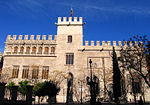Province of Valencia
Pages with Spanish IPAPages with Valencian IPAProvince of ValenciaSource attribution

Valencia (Spanish: [baˈlenθja]), natively also València (Valencian: [vaˈlensi.a, -sja]), is a province of Spain, in the central part of the autonomous Valencian Community. Of the province's 2.6 million people (2021), one-third live in the capital, Valencia, which is also the capital of the autonomous community and the 3rd biggest city in Spain, with a metropolitan area of 2,522,383 people it is also one of the most populated cities of Southern Europe. There are 265 municipalities in the province.
Excerpt from the Wikipedia article Province of Valencia (License: CC BY-SA 3.0, Authors, Images).Province of Valencia
Plaça de Manises, Valencia Ciutat Vella
Geographical coordinates (GPS) Address Nearby Places Show on map
Geographical coordinates (GPS)
| Latitude | Longitude |
|---|---|
| N 39.477222222222 ° | E -0.37666666666667 ° |
Address
Diputació de València
Plaça de Manises 4
46003 Valencia, Ciutat Vella
Valencian Community, Spain
Open on Google Maps











